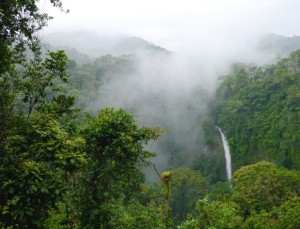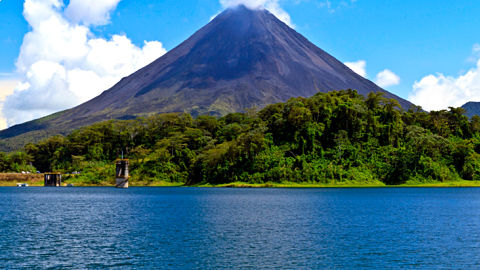Costa Rica Travel News – When you’ve been living in a thatched-roof hut in the Costa Rican rainforest, the sights, smells and sounds of the jungle eventually have a calming effect.
 From my hammock out front, I relax, watching delicate hummingbirds hover and zip around the exotic flowers and lush foliage that seem ready to swallow up our cozy living space.
From my hammock out front, I relax, watching delicate hummingbirds hover and zip around the exotic flowers and lush foliage that seem ready to swallow up our cozy living space.
Vultures circle high above the forest canopy, hoping for something below to pass on. The scream of howler monkeys nearby pierces the jungle din while we stuff ourselves with fresh mango, pineapple and a rice and bean concoction known as “spotted rooster.”
After two days in one place, Lisa and I are ready to move on and discover the other riches of this country, the pristine beaches, gnarly waves, jungles teeming with white-faced monkeys and scarlet macaws, smouldering volcanoes and arguably the best weather in the world. Maybe we’ll even catch a glimpse of the elusive and resplendently iridescent quetzal.
In the parking lot a short walk from the hut, our Kia Sportage rental vehicle awaits its mission. Our plan is to drive from Puerto Viejo, in the southeast corner of the country not far from the Panama border, west to Playa Hermosa on the Pacific coast, just south of the Nicaragua frontier. We could take the tourist route back to the capital, San Jose, then north up the inter-American Highway. But that would be too predictable.
Instead, while I pack the Sportage, Lisa plans a direct route across the country, which, by her estimate, is about 500 kilometres. Averaging 50 km/h, she figures it will take us about 10 hours. Time to hit the road.
As I manoeuvre the turbo dieselpowered, five-speed manual Sportage around the maze of potholes and washouts through Puerto Viejo, I remember the ominous parting words of the car rental agent after trying to rent a GPS unit on the grounds that route directions in Costa Rica are scarce.
“Never leave the car unattended.
Hire a guard when you stop or make sure it remains in sight.”
We spend the morning cruising the endless banana plantations of the Caribbean lowlands, slowly settling into the fact that we are indeed on vacation. Cellphones, BlackBerrys, laptop computers and an endless schedule of meetings are back home in Halifax.
As we begin the climb into the mountains I spot a “soda,” the Costa Rican version of a roadside diner. At this tidy corrugated metal-roofed eatery, there are no gringos. There are none of those mini-buses we noticed back on the main roads plastered with “Turismo” stickers that, like baby-onboard signs, suggest we keep away from pampered cargo.
While Lisa freshens up in the bathroom, through a series of hand signs and caveman Spanish, I manage to get off two orders of arroz con pollo, the ubiquitous Tico menu item, a perfect mound of rice and chicken.
When Lisa returns, a man with the air of ownership comes over to take our order. All we need to do is say we had already ordered but nothing comes out except a series of panicked grunts. We simply do not have the ability to say, “We’ve ordered.” And without the waitress in the vicinity to point to or rescue us, we just sit there mumbling, “No, gracias, no, gracias.”
No wonder they call us gringos! After lunch we continue to climb into the Cordillera de Tilaran crossing the Continental Divide east of Volcán Arenal, one of the most active volcanoes in the world. We get lost a couple of times but through a series of estimates and luck, we make good progress.
Hey, I don’t surf. Climbing volcanoes and stomping through jungles in search of macaws and sloths is something other people do. I’d rather be steering around fallen trees and dodging kamikaze drivers on the winding, narrow back roads where “turismo”-stickered mini-buses are about as rare as Burger King restaurants.
There aren’t many North American vehicles on the road, just the odd Chevy Cavalier and a few beat-up Ford and Dodge pickups. It is mostly Asian products and the lion’s share of nameplates are not Toyota, Nissan and Honda but Hyundai and Kia. The Koreans are everywhere.
Late in the afternoon, Lisa suggests a shortcut off the main route to the Pacific coast. I had just dropped the Sportage into a pothole so deep the car hung up on the frame, leaving the left front wheel hanging in the air, but we managed to drive out of that predicament without any damage. With 39,000 kilometres on the odometer, it amazes me that this Kia Sportage is completely rattle-, squeak-and vibration-free, especially considering the state of many Costa Rican roads.
The shortcut shows its true colours when we dead-end at a mangrove swamp and puncture a tire turning around. After putting the spare on, it’s still 25 kilometres of brutal road out of this “shortcut.” The road is so rough, it takes a tense two hours to go those last 25 kilometres. Without a spare tire, all we can think about is being stranded for the night with another flat tire.
But we make Playa Hermosa as the sun sinks into the shimmering Pacific Ocean and I pat the trusty Sportage on its dusty dashboard. Piña coladas at our surfside hotel go down well.
In the morning, our first stop is the busiest place in town, a tire repair shop where a slew of gringos are lined up with their rental cars. A couple from San Francisco recounts their three flat tires in three days, and they stayed on the pavement.
Pulling out of the tire shop, about to tackle another day of Costa Rican backroads and shortcuts, I notice a couple of mini-buses headed down the main road toward the beach.
Their bright yellow “turismo” stickers reflect the morning sunlight.
BY GARRY SOWERBY, VANCOUVER SUN

